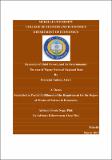| dc.description.abstract | The purpose of this paper is to study the dynamics of child poverty and its determinants in Tigray
Regional National State. In attempting the study, the author analyzes 2 rounds (2002 and 2006)
panel data set on 365 sampled children collected through the young lives’ project. The central
question that this essay address is: What factors account for the pattern of child poverty? That
is, which household demographic and socioeconomic variables emerge as determinants of child
poverty?
The data analysis techniques involved are both descriptive and econometric models. The specific
statistics used includes percentage, mean, and standard deviation in the descriptive statistics and
multinomial logit model in the econometrics analysis. To investigate the study area, the author
uses anthropometric indicators of weight for age and height/length for age. The results of the
study revealed that, the poverty head count ratio of the sampled children, obtained by having the
standard cutoff (-2 z score) indicates that over time there is a gradual decrease in the rate of
child poverty severity when measured by percentages of both underweight and stunting on the
same time between rounds 1 and 2, i.e. from 23 percent (84/365) in 2002 to 13 percent (46/365)
in 2006.
The descriptive and econometric evidences indicate that child poverty is associated with sex of
the household head, number of children in the household, wealth of the household, household
head education and place of residence. While residence in rural areas and wealth of the
household are common factors that significantly predict child poverty (poor and extreme),
numbers of children in the household and household head education uniquely predict extreme
child poverty.
Lastly, the transition matrices reflect that the movements of poor children between two
consecutive survey rounds in relation to the standard cutoff (-2 Z score) is significant. Out of the
total non poor children in 2002, 30 percent (65/217) entered in to poverty by 2006. The
corresponding exit rate from poverty was 40 percent (60/148) over this period.
The result of this study implies that taking into account of these determinant factors policy
makers should be mindful on both food aid and investing on non food items, which this may be
vital in reducing child poverty. | en_GB |


